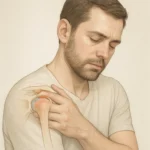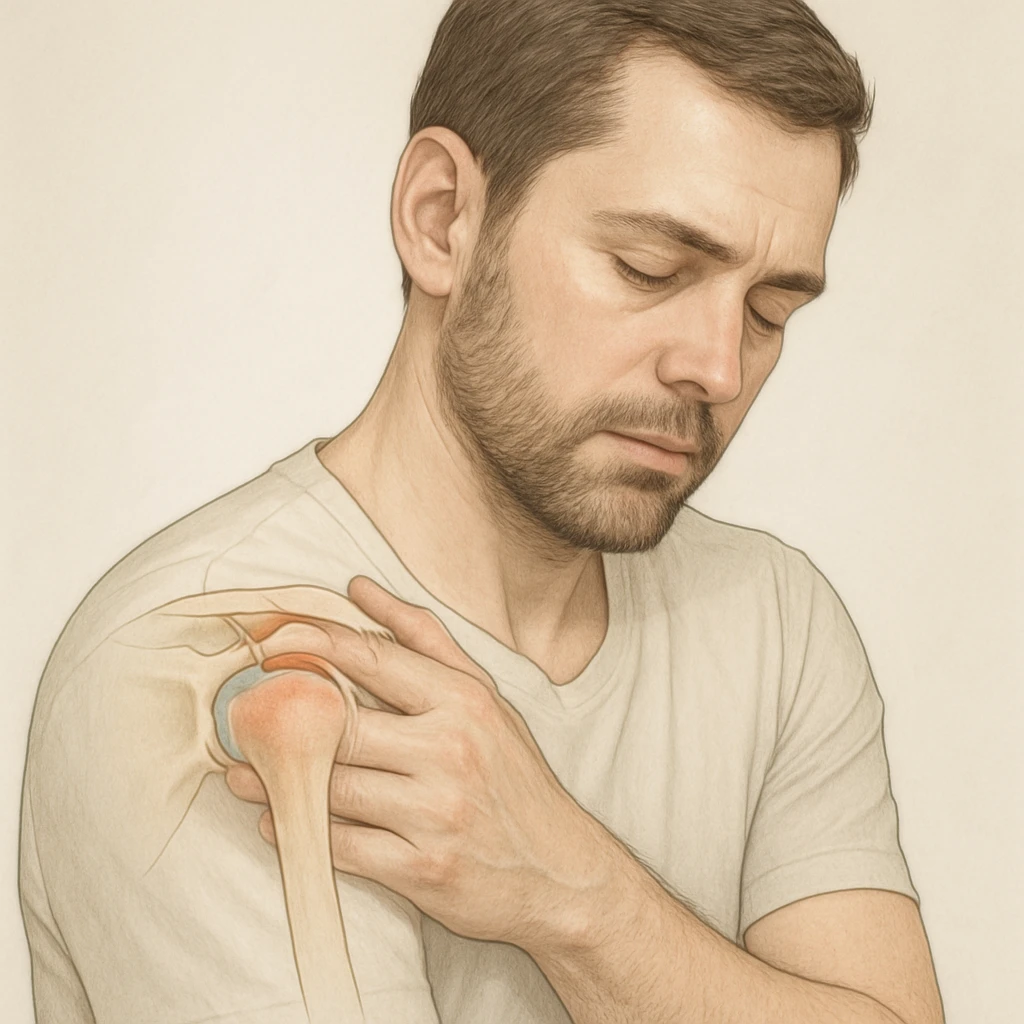
Managing Shoulder Stiffness: What to Expect During Recovery
What Shoulder Stiffness Means and Why Etiology Matters
Shoulder stiffness refers to a reduction in the normal range of motion of the glenohumeral joint, often accompanied by discomfort or functional limitation. While this stiffness may appear similar across patients, its underlying causes can differ significantly. Distinguishing these causes is essential because management strategies vary depending on the specific pathology contributing to the loss of motion.
Defining Shoulder Stiffness
Shoulder stiffness may result from a variety of conditions, including inflammation, degenerative joint changes, tendon injury, or neurologic involvement. One well-known cause is adhesive capsulitis, a condition characterized by progressive limitation of both active and passive motion. Adhesive capsulitis often follows a characteristic clinical course with phases commonly described as freezing, frozen, and thawing, during which pain and stiffness evolve over time.
However, not all shoulder stiffness reflects adhesive capsulitis. Diagnosis is primarily clinical, relying on a detailed history and examination, particularly assessing passive range of motion. Limited passive motion is a key diagnostic feature when evaluating true adhesive capsulitis. Identifying any preceding trauma, surgery, or systemic condition can further clarify the etiology and inform treatment planning.
Myth vs Fact: ‘All Shoulder Stiffness Equals Frozen Shoulder’
It is a common misconception that any shoulder with restricted movement is experiencing frozen shoulder. In reality, several distinct disorders can produce similar limitations:
- Rotator cuff pathology may limit movement due to pain, but passive motion may remain relatively preserved.
- Glenohumeral osteoarthritis can cause mechanical restriction from joint space narrowing.
- Cervical radiculopathy may produce referred pain and perceived shoulder weakness.
- Calcific tendinopathy can lead to acute pain and temporary guarding.
Differentiating these conditions relies on careful clinical assessment, guided shoulder examination, and selective use of imaging to rule out alternative explanations. Recognizing the correct etiology is central to selecting appropriate management strategies and setting realistic expectations for recovery.
Who Is Affected and Why: Risk Factors and Disease Mechanisms
Shoulder stiffness, particularly in the form of adhesive capsulitis, does not occur randomly. Instead, it reflects a combination of individual risk factors and biological processes that influence how the glenohumeral joint responds to injury, inflammation, or systemic conditions. Understanding who is more likely to develop stiffness and why the joint becomes restricted helps guide both prevention and tailored treatment.
Metabolic and Systemic Associations
Adhesive capsulitis is more common in patients with metabolic or endocrine disorders, especially diabetes and thyroid disease. Although the precise mechanisms continue to be investigated, these conditions are associated with biochemical changes that may alter connective tissue structure and inflammatory responses. Patients with diabetes, for example, frequently experience thickening and reduced elasticity of soft tissues, which can contribute to limitations in joint mobility.
- Diabetes
- Thyroid dysfunction
- Altered collagen turnover and connective tissue characteristics
This elevated risk does not imply inevitability, but it does suggest the need for early recognition and monitoring, particularly when shoulder discomfort or reduced motion first develops. Similarly, individuals with thyroid dysfunction may have systemic effects on collagen turnover and tissue metabolism that predispose them to stiffness. In both cases, recognizing the underlying systemic contributor provides context for the clinical presentation and helps shape expectations for recovery.
Mechanical and Immobilization Factors
Mechanical factors also play an important role in shoulder stiffness, particularly in situations where the shoulder remains immobile for an extended period. Prolonged shoulder immobilization increases the likelihood of stiffness because the capsular tissues and surrounding musculature depend on regular movement to maintain flexibility. When the shoulder is held still due to injury, pain avoidance, or protective bracing, the lack of motion may initiate a cycle of tissue tightening and reduced range.
- Post-injury protective guarding
- Postoperative immobilization
- Pain-related avoidance of shoulder movement
This process may begin gradually and can be overlooked early on. However, once stiffness develops, the resulting loss of motion can make normal activities more difficult, reinforcing patterns of reduced use. Recognizing immobilization as a risk factor underscores the importance of guided, controlled motion when clinically appropriate, especially after injury or surgery.
Capsular Inflammation and Fibrosis
At the tissue level, shoulder stiffness in adhesive capsulitis is marked by inflammation and fibrosis of the glenohumeral capsule. Initially, inflammation may cause pain and sensitivity, influencing how the shoulder is used and how much motion is tolerated. Over time, this inflammation can lead to structural thickening of the capsule and reduced joint volume, making motion physically restricted even when pain decreases.
This reduction in joint space and increased capsular tension explain why patients often describe a sense of the shoulder being “stuck” rather than simply sore. The progression from inflammation to fibrotic change helps clarify why adhesive capsulitis can evolve across distinct clinical phases and why recovery may require sustained and gradual efforts to restore mobility.
Recognizing and Differentiating Clinical Presentations
Identifying adhesive capsulitis and distinguishing it from other causes of shoulder pain requires careful attention to how symptoms evolve over time and how the joint behaves on physical examination. Although multiple disorders can limit shoulder function, adhesive capsulitis follows a recognizable pattern that can guide diagnostic reasoning when approached methodically.
Symptom Patterns Over Time
Adhesive capsulitis typically develops gradually, beginning with progressive shoulder pain that may be most noticeable at night or during overhead activities. Pain often precedes stiffness, and individuals may initially notice difficulty reaching behind the back or performing routine movements that require shoulder rotation. As the condition advances, stiffness becomes more prominent and pain may decrease in intensity but persists during end-range motion.
- Early stage: pain more prominent, especially at night
- Progression: increasing stiffness and reduced motion
- Later stage: pain less intense but movement mechanically limited
This transition from a pain-dominant phase to one marked by substantial loss of motion reflects the underlying biological changes in the shoulder joint. Over time, the capsule becomes less flexible, contributing to a reduced ability to move the joint through its full arc. Patients commonly describe a feeling that the shoulder is difficult to move, even when actively trying to push through the stiffness, indicating a mechanical limitation rather than solely pain guarding.
Physical Examination Hallmarks
On examination, adhesive capsulitis is characterized by a global limitation of both active and passive range of motion. This means that even when an examiner attempts to move the patient’s shoulder, the motion remains restricted. External rotation is often the most affected, and comparing this movement to the unaffected side can be particularly informative. This finding distinguishes adhesive capsulitis from conditions where pain alone limits movement but passive mobility remains intact.
- Global reduction in active and passive ROM
- Notable restriction in external rotation
- Symmetric limitation across multiple planes of motion
Assessing range of motion in multiple planes, including forward elevation, abduction, and external rotation, helps establish the degree and distribution of motion loss. Evaluating whether the limitation is consistent across both active and passive movement provides valuable insight into whether the capsule itself is restricted, which is central to confirming adhesive capsulitis as the primary diagnosis.
Differentiating from Other Disorders
Several conditions can mimic elements of adhesive capsulitis, so differentiation is essential. Rotator cuff pathology may reduce active motion due to weakness or pain, but passive motion is usually less restricted. Glenohumeral osteoarthritis can cause stiffness, but mechanical changes within the joint rather than capsular tightness are responsible. Cervical radiculopathy may produce referred shoulder discomfort and perceived weakness without significant restrictions in passive shoulder movement.
Calcific tendinopathy can cause acute pain and temporary guarding that appears similar to early adhesive capsulitis, but the intensity and sudden onset of pain, along with localized tenderness, help distinguish it. Imaging studies are used selectively to rule out these alternative explanations rather than to confirm adhesive capsulitis itself. Once these possibilities are excluded and the pattern of global passive and active restriction is established, the diagnosis becomes clearer.
| Condition | Passive ROM | Key Distinguishing Feature |
|---|---|---|
| Adhesive Capsulitis | Restricted | Global limitation, especially external rotation |
| Rotator Cuff Tear | Near normal | Weakness on resisted testing |
| Glenohumeral Osteoarthritis | Restricted | Mechanical crepitus and joint space changes |
| Cervical Radiculopathy | Normal | Neck symptoms and radiation pattern |
| Calcific Tendinopathy | Variable | Acute pain with localized tenderness |
Evidence-Based Management and Prevention Strategies
Management of shoulder stiffness follows a structured, stepwise approach that prioritizes nonoperative treatments before considering procedural interventions. This hierarchy reflects the natural course of adhesive capsulitis, in which many individuals gradually improve with time, guided mobility, and targeted symptom management. When early strategies are inadequate or stiffness follows surgery or injury, additional therapeutic options may be introduced based on clinical need.
Conservative Care First-Line
Supervised physical therapy combined with a consistent home stretching program is considered the foundational approach to treating shoulder stiffness. Therapeutic goals focus on restoring range of motion gradually, reducing discomfort associated with movement, and improving function during daily activities. Stretching exercises are typically introduced gradually and adjusted according to tolerance to prevent exacerbating inflammation while promoting capsular mobility.
- Supervised range-of-motion exercises
- Progressive stretching and mobility work
- Activity modification to reduce pain-related guarding
Intra-articular corticosteroid injections may be used in the early stages of adhesive capsulitis to decrease pain that limits participation in therapy. Reducing pain can enable more effective engagement in stretching and mobilization exercises. The benefit of these injections lies not in reversing stiffness directly but in improving the conditions under which rehabilitation can proceed.
When Early Progress Plateaus
In some cases, improvement with conservative care occurs slowly or reaches a temporary plateau. When this happens, additional interventions may be considered. Hydrodilatation, which involves introducing fluid into the joint capsule to expand its volume, may accelerate recovery by helping the capsule stretch more effectively. This technique is typically paired with ongoing therapeutic exercises to reinforce the mobility gained.
For patients with persistent, function-limiting shoulder stiffness despite consistent nonoperative treatment, more advanced interventions may be discussed. Manipulation under anesthesia allows the provider to mobilize the shoulder joint while the patient is relaxed, which may help loosen tight capsular tissue. Alternatively, arthroscopic capsular release involves surgically releasing portions of the restricted capsule to restore movement. These options are generally reserved for cases where conservative therapies have been given adequate time to produce results.
| Intervention | Primary Aim | Typical Use Case |
|---|---|---|
| Hydrodilatation | Expand capsule to improve range | When progress with therapy slows |
| Manipulation Under Anesthesia | Break capsular adhesions | Stiffness persists despite nonoperative care |
| Arthroscopic Capsular Release | Selective surgical release of capsule | Refractory or severe motion limitation |
Postoperative Stiffness and Rehabilitation Timing
Stiffness that develops after shoulder surgery or injury follows similar principles but requires careful timing and coordination with healing processes. After rotator cuff repair or fracture management, immobilization is sometimes initially necessary to protect the repair. However, prolonged immobility increases the likelihood of stiffness due to tightening of the capsular tissues.
- Initial protection of surgical repair
- Progressive reintroduction of motion
- Interdisciplinary coordination between surgical and therapy teams
To balance protection with mobility, rehabilitation strategies emphasize early, controlled motion when clinically appropriate. This involves gradually reintroducing shoulder movements under professional supervision to preserve joint flexibility without compromising tissue healing. Effective communication between surgical and rehabilitation teams ensures these decisions align with procedural considerations and patient-specific factors.
Recovery Expectations and Prevention
Most patients with shoulder stiffness regain meaningful functional range of motion with nonoperative care, although the process can take months and progress may vary among individuals. Understanding that recovery is often gradual helps set realistic expectations and encourages ongoing engagement in therapeutic exercises even when improvement appears slow.
- Recovery is gradual and often measured in months
- Continued activity supports long-term mobility
- Early response to stiffness improves outcomes
Prevention strategies emphasize movement and joint use when safe. After injury or surgery, initiating gentle range-of-motion exercises as soon as it is medically appropriate reduces the likelihood of stiffness developing. Individuals with known risk factors, such as metabolic conditions, may benefit from earlier monitoring and proactive mobility exercises at the onset of discomfort. Sustaining flexibility and joint use over time helps maintain shoulder function and reduces the risk of recurrent stiffness.
- Adhesive capsulitis is more common in individuals with diabetes or thyroid disease.
- Prolonged shoulder immobilization increases the likelihood of developing shoulder stiffness.
- Shoulder stiffness most often affects adults in middle age.
- Progressive shoulder pain, especially at night, is commonly followed by notable stiffness.
- The condition involves reduced active and passive range of motion, particularly external rotation.
- Inflammation and fibrosis of the shoulder capsule limit joint space and movement.
- Diagnosis relies on clinical evaluation, with imaging primarily used to rule out other causes.
- Most individuals regain functional shoulder motion over time with nonoperative management.
Frequently Asked Questions
Is shoulder stiffness the same as a frozen shoulder?
No. While frozen shoulder (adhesive capsulitis) is a common cause of shoulder stiffness, other conditions like rotator cuff injury or arthritis can also limit motion. Diagnosis depends on examining both active and passive range of motion.
How long does shoulder stiffness usually last?
The timeline varies. Some individuals improve over several months, while others experience symptoms for a year or longer. Gradual progress is typical, especially with guided movement and stretching.
Why is shoulder stiffness often worse at night?
Inflammation and sensitivity around the joint capsule can make certain positions painful while resting. Night pain is particularly common in the early inflammatory phase of adhesive capsulitis.
Does shoulder stiffness always require imaging?
No. Diagnosis is usually based on medical history and physical examination. Imaging is mainly used to rule out other causes like rotator cuff tears or arthritis.
Can shoulder stiffness develop after surgery or injury?
Yes. When the shoulder remains immobile for a prolonged period, the capsule and surrounding tissues can tighten. Early, controlled motion during recovery helps reduce the risk.
Are corticosteroid injections helpful?
They can be. Corticosteroid injections may reduce pain in the early stages, making it easier to participate in stretching and physical therapy.
Will shoulder stiffness improve without surgery?
Most people regain functional motion over time with nonoperative care such as stretching and supervised therapy. Surgical interventions are considered only when symptoms remain severe despite consistent treatment.




















